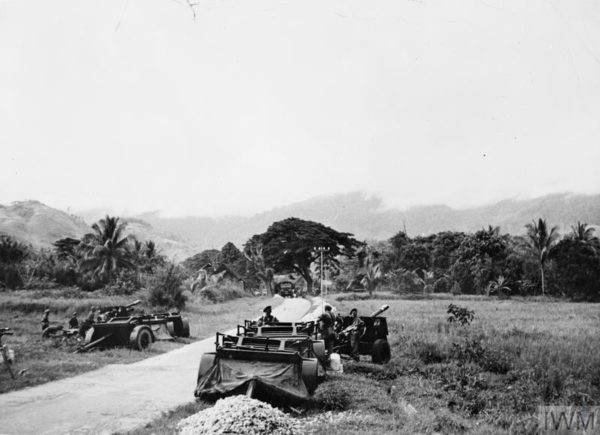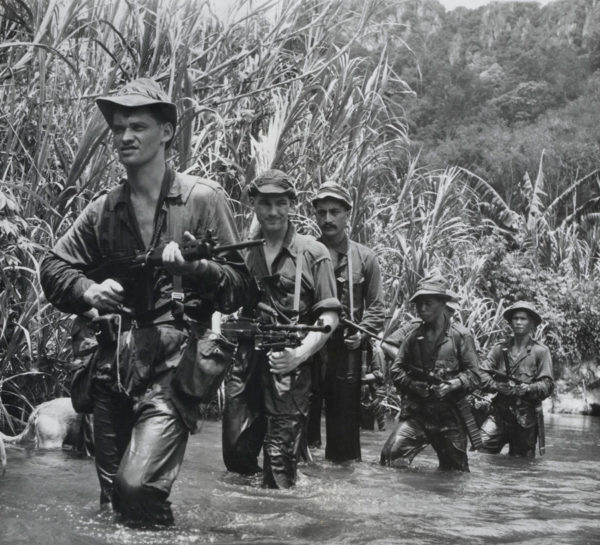Malay Emergency Instead of War so Insurers will Pay
Headline from New York Times 16 August 1951

THE MALAYAN EMERGENCY 1948-1960 (BF 48) British 25 pounder field guns of the Royal Artillery in position outside a Malayan village during the Malayan Emergency. They are ready to give fire support if called for by the infantry. Copyright: © IWM. Original Source: http://www.iwm.org.uk/collections/item/object/205212425
IT IS NOT A WAR
Had the British government used the word “war” then Lloyds of London and other property insurers would have been able to avoid paying out damage claims on policies written on tin mines, rubber plantations, and manufacturing plants destroyed or damaged in war.
Insurance policies written for property exclude from recompense damages caused by war and “Acts of God.” These are defined as natural catastrophes over which no human agency could exert control or cause. Tornadoes, hurricanes, volcanic eruptions, typhoons, tidal waves, etc are “Acts of God” in the legal sense of the term.
Many policies also include exemptions from paying claims for civil unrest, riot, and other events of mass violence. What constitutes such events are the kinds of things which keep lawyers busy.

Malay and New Zealand soldiers on a jungle patrol, c1957From 1954 there were normally 24 infantry battalions in Malaya from a wide variety of Commonwealth countries, including the 2nd Battalion The Royal Australian Regiment and 1st Battalion The New Zealand Regiment. These were supported by specialised units such as the Special Air Service (SAS) Regiment. With a police force of 40,000 men it was now possible to clear an area of guerrillas. When an area had been swept it was designated a ‘White Area’ and restrictions on the local population were lifted, encouraging them to oppose the return of any insurgents. (British National Army Museum) Taken from http://www.nam.ac.uk/exhibitions/online-exhibitions/malayan-emergency
BRITISH ADVISER SCORNS ESCORT
“Don’t you think, sir, you should have an escort,” said a policeman to the British Adviser to the Sultan of Perak, then part of the British colony of Malaysia. A Communist insurgency had recently broken out and the Adviser had come to inspect a rubber plantation where several British estate managers had just been murdered by Communist thugs.
“Escort? Good God! Why on earth should I need an escort? I’ve got my walking stick and my wife.”
[Source: War of the Running Dogs: Malaya, 1948-1960 by Noel Barber, foreign correspondent of the London Daily Mail in the 1950s and 1960s who later became a bestselling novelist including several romance novels the most famous of which was “A Farewell to France.”

Malayan police in an armoured car, c1952. In 1950 Lieutenant-General Sir Harold Briggs was appointed Director of Operations in Malaya. He realised the importance of isolating the guerrillas from their sources of food and creating a sense of security in populated areas so that people would be more willing to provide information. He also persuaded the High Commissioner, Sir Henry Gurney, to set up committees containing representatives of all civil and military agencies involved in the campaign so that a co-ordinated response to the guerrillas could be formulated. The Malayan Police and Special Branch were given the task of gathering information. Taken from http://www.nam.ac.uk/exhibitions/online-exhibitions/malayan-emergency

Gurkhas enjoy a brew-up during jungle operations, 1959.In August 1957 the Federation of Malaya was granted independence and the insurrection lost its rationale as a war of colonial liberation. Many guerrillas gave up their fight. In 1960 the emergency was declared to be over. Over 500 soldiers and 1300 police had been killed during the conflict. Communist losses are estimated at over 6000 killed and 1200 captured. The campaign was one of the few successful counter-insurgency operations undertaken by the Western powers. Taken from http://www.nam.ac.uk/exhibitions/online-exhibitions/malayan-emergency
Communist Insurgency Supported by Red China
The Communist insurgency in Malaya was heavily supported by the Communist Government of the People’s Republic of China. In spite of the immense difficulties involved in chasing down the Communist guerrillas and killing or capturing them in some of the most forbidding terrain in the world, this was the only successful anti-Communist campaign won by any of the Western powers in Asia that did not involve either outright defeat or a partition of the original nation.
British Re-Occupy Malaysia After Japanese Defeat
After the defeat of the Japanese, the British re-occupied Malaysia which had been a British crown colony before World War Two, that is, a colony ruled by a Governor appointed by the Crown as advised by the sitting Prime Minister. The British wanted the opportunity to re-open tin mines and rubber plantations because of their desperate need of foreign currency.
The British were also determined to hand over a stable, democratic, free and independent nation to the native Malay officials and Parliament. It was a very long haul. This conflict began in 1948 and continued until the destruction of Communist forces in 1960.

THE MALAYAN EMERGENCY 1948-1960 (MAL 157) British and Malay infantry being transported up river on an armed launch of the Malayan Naval Force during a sweep to locate communist guerillas hidden ain the jungle along the riverside. Copyright: © IWM. Original Source: http://www.iwm.org.uk/collections/item/object/205212404
Malaysian Soldiers, Police With British and Commonwealth Troops Win the Day
Through the use of Malaysia soldiers and police, British and Commonwealth troops, and funds and supplies from the USA, the British succeeded and after they succeeded, they left. This was one of the few success stories of a country emerging intact from its days as a colony of the British Empire. Malaysia was and continues to be a multi-ethnic state because over the decades the British glued different pieces of territories into one colony. So it wasn’t as if one large piece of territory was just sitting there and they came along and snatched it.
The British Empire was built on trade and the suppression of ethnic violence
The British Empire was built on trade and the suppression of ethnic violence. In many colonies, the ethnic mix was such that these different groups had been warring with each other for endless amounts of time. The British usually imposed order by recruiting native police and military units under British command backed up by British troops and the Royal Navy. Hence, there was an unspoken social contract. The British ruled the colony and made money from it and in return provided order and stability so that native elites could also make money and maintain their traditional powers.

THE MALAYAN EMERGENCY, 1948-1960 (MAL 2) A patrol of the Security Forces, possibly from either the Malayan Police Field Force or the Malayan Regiment, prepare to travel by raft down a river in the Temenggor area of northern Malaya. The local men accompanying the troops were employed as armed trackers, scouts, guides and boatmen. Copyright: © IWM. Original Source: http://www.iwm.org.uk/collections/item/object/205212411
Malaysia was never a “settlement” colony such as Canada or Australia
Malaysia was never a “settlement” colony such as Canada or Australia. At its peak, the white population before World War Two might have numbered 10,000 people. The brutally hot climate of Malaysia was such that few white Europeans wanted to go there for any length of time. It was a trading colony exporting raw sap from rubber trees as well as an immense amount of tin from mines that had been opened up. Because of this, Malaya earned large amounts of foreign currency, especially dollars for the British, and this became more and more important as the twentieth century went on.